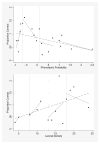The effect of incremental changes in phonotactic probability and neighborhood density on word learning by preschool children
- PMID: 23882005
- PMCID: PMC4049320
- DOI: 10.1044/1092-4388(2013/12-0245)
The effect of incremental changes in phonotactic probability and neighborhood density on word learning by preschool children
Abstract
Purpose: Phonotactic probability or neighborhood density has predominately been defined through the use of gross distinctions (i.e., low vs. high). In the current studies, the authors examined the influence of finer changes in probability (Experiment 1) and density (Experiment 2) on word learning.
Method: The authors examined the full range of probability or density by sampling 5 nonwords from each of 4 quartiles. Three- and 5-year-old children received training on nonword-nonobject pairs. Learning was measured in a picture-naming task immediately following training and 1 week after training. Results were analyzed through the use of multilevel modeling.
Results: A linear spline model best captured nonlinearities in phonotactic probability. Specifically, word learning improved as probability increased in the lowest quartile, worsened as probability increased in the mid-low quartile, and then remained stable and poor in the 2 highest quartiles. An ordinary linear model sufficiently described neighborhood density. Here, word learning improved as density increased across all quartiles.
Conclusion: Given these different patterns, phonotactic probability and neighborhood density appear to influence different word learning processes. Specifically, phonotactic probability may affect recognition that a sound sequence is an acceptable word in the language and is a novel word for the child, whereas neighborhood density may influence creation of a new representation in long-term memory.
Keywords: neighborhood density; phonotactic probability; spline regression; vocabulary; word learning.
Figures

Similar articles
-
Effect of phonotactic probability and neighborhood density on word-learning configuration by preschoolers with typical development and specific language impairment.J Speech Lang Hear Res. 2014 Jun 1;57(3):1011-25. doi: 10.1044/2014_JSLHR-L-12-0282. J Speech Lang Hear Res. 2014. PMID: 24686926 Free PMC article.
-
The influence of part-word phonotactic probability/neighborhood density on word learning by preschool children varying in expressive vocabulary.J Child Lang. 2011 Jun;38(3):628-43. doi: 10.1017/S0305000910000176. Epub 2010 Jul 8. J Child Lang. 2011. PMID: 20609282 Free PMC article.
-
Differentiating phonotactic probability and neighborhood density in adult word learning.J Speech Lang Hear Res. 2006 Dec;49(6):1175-92. doi: 10.1044/1092-4388(2006/085). J Speech Lang Hear Res. 2006. PMID: 17197489 Free PMC article.
-
Understanding Bilingual Word Learning: The Role of Phonotactic Probability and Phonological Neighborhood Density.J Speech Lang Hear Res. 2017 Dec 20;60(12):3551-3560. doi: 10.1044/2017_JSLHR-L-15-0376. J Speech Lang Hear Res. 2017. PMID: 29114764
-
The Effects of Phonotactic Probability and Neighborhood Density on Adults' Word Learning in Noisy Conditions.Am J Speech Lang Pathol. 2016 Nov 1;25(4):547-560. doi: 10.1044/2016_AJSLP-14-0165. Am J Speech Lang Pathol. 2016. PMID: 27788276 Free PMC article.
Cited by
-
A corpus of consonant-vowel-consonant real words and nonwords: comparison of phonotactic probability, neighborhood density, and consonant age of acquisition.Behav Res Methods. 2013 Dec;45(4):1159-67. doi: 10.3758/s13428-012-0309-7. Behav Res Methods. 2013. PMID: 23307574 Free PMC article.
-
Combining statistics: the role of phonotactics on cross-situational word learning.Psicol Reflex Crit. 2022 Sep 28;35(1):30. doi: 10.1186/s41155-022-00234-y. Psicol Reflex Crit. 2022. PMID: 36169750 Free PMC article.
-
How Mixed-Effects Modeling Can Advance Our Understanding of Learning and Memory and Improve Clinical and Educational Practice.J Speech Lang Hear Res. 2019 Mar 25;62(3):507-524. doi: 10.1044/2018_JSLHR-L-ASTM-18-0240. J Speech Lang Hear Res. 2019. PMID: 30950737 Free PMC article.
-
Online learning from input versus offline memory evolution in adult word learning: effects of neighborhood density and phonologically related practice.J Speech Lang Hear Res. 2014 Oct;57(5):1708-21. doi: 10.1044/2014_JSLHR-L-13-0150. J Speech Lang Hear Res. 2014. PMID: 24686841 Free PMC article. Clinical Trial.
-
Speech Segmentation and Cross-Situational Word Learning in Parallel.Open Mind (Camb). 2023 Jul 28;7:510-533. doi: 10.1162/opmi_a_00095. eCollection 2023. Open Mind (Camb). 2023. PMID: 37637304 Free PMC article.
References
-
- Baayen RH, Davidson DJ, Bates DM. Mixed-effects modeling with crossed random effects for subjects and items. Journal of Memory and Language. 2008;59(4):390–412.
-
- Balaban MT, Waxman SR. Do words facilitate object categorization in 9-month-old infants? Journal of Experimental Child Psychology. 1997;64(1):3–26. - PubMed
-
- Cnaan A, Laird NM, Slasor P. Using the general linear mixed model to analyze unbalanced repeated measures and longitudinal data. Statistics in Medicine. 1997;16:2349–2380. - PubMed
-
- Creel SC. Phonological similarity and mutual exclusivity: on-line recognition of atypical pronunciations in 3–5-year-olds. Developmental Science. 2012:1–18. - PubMed
-
- Dumay N, Gaskell MG. Sleep-associated changes in the mental representation of spoken words. Psychological Science. 2007;18(1):35–39. - PubMed
Publication types
MeSH terms
Grants and funding
LinkOut - more resources
Full Text Sources
Other Literature Sources

